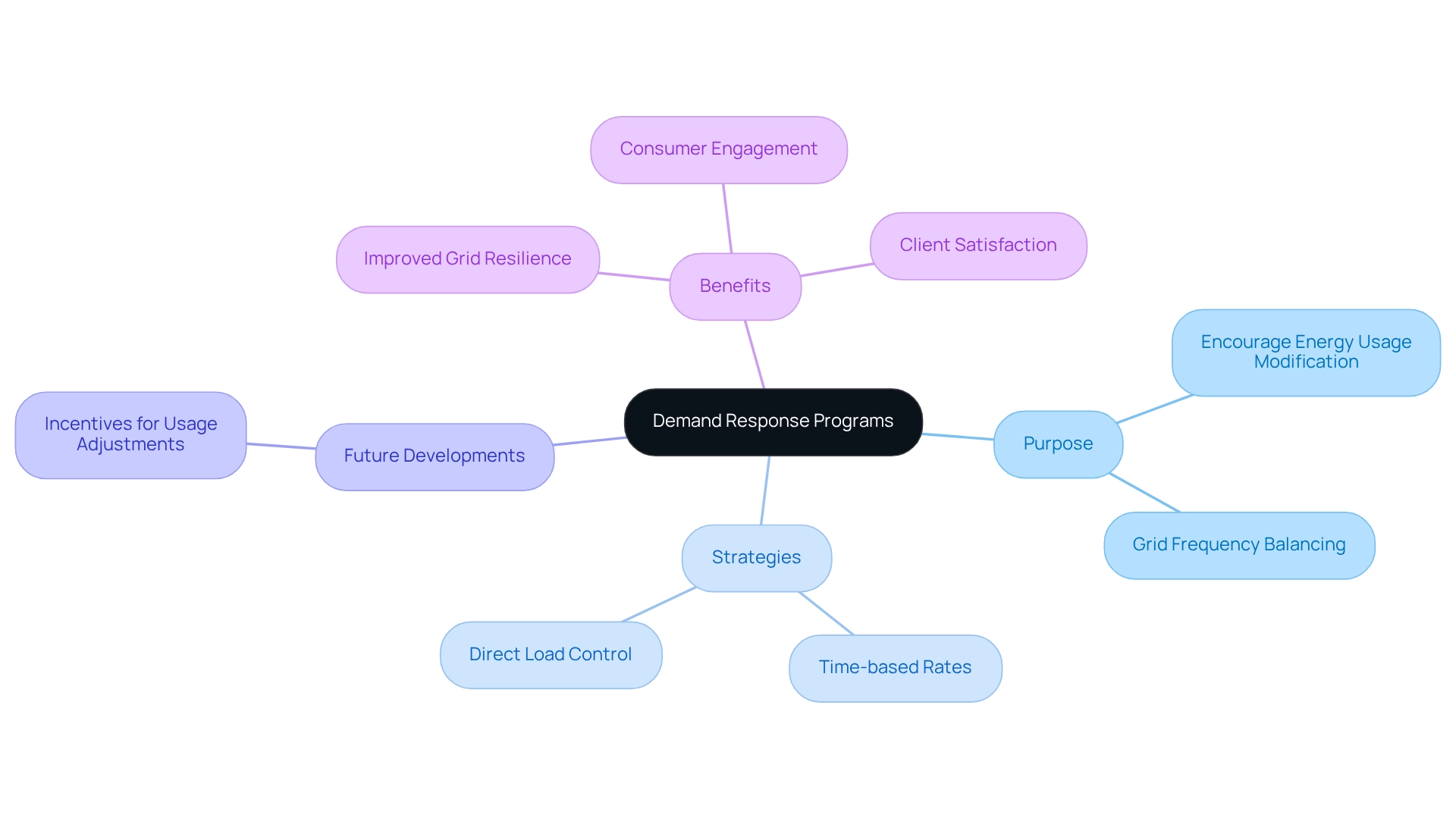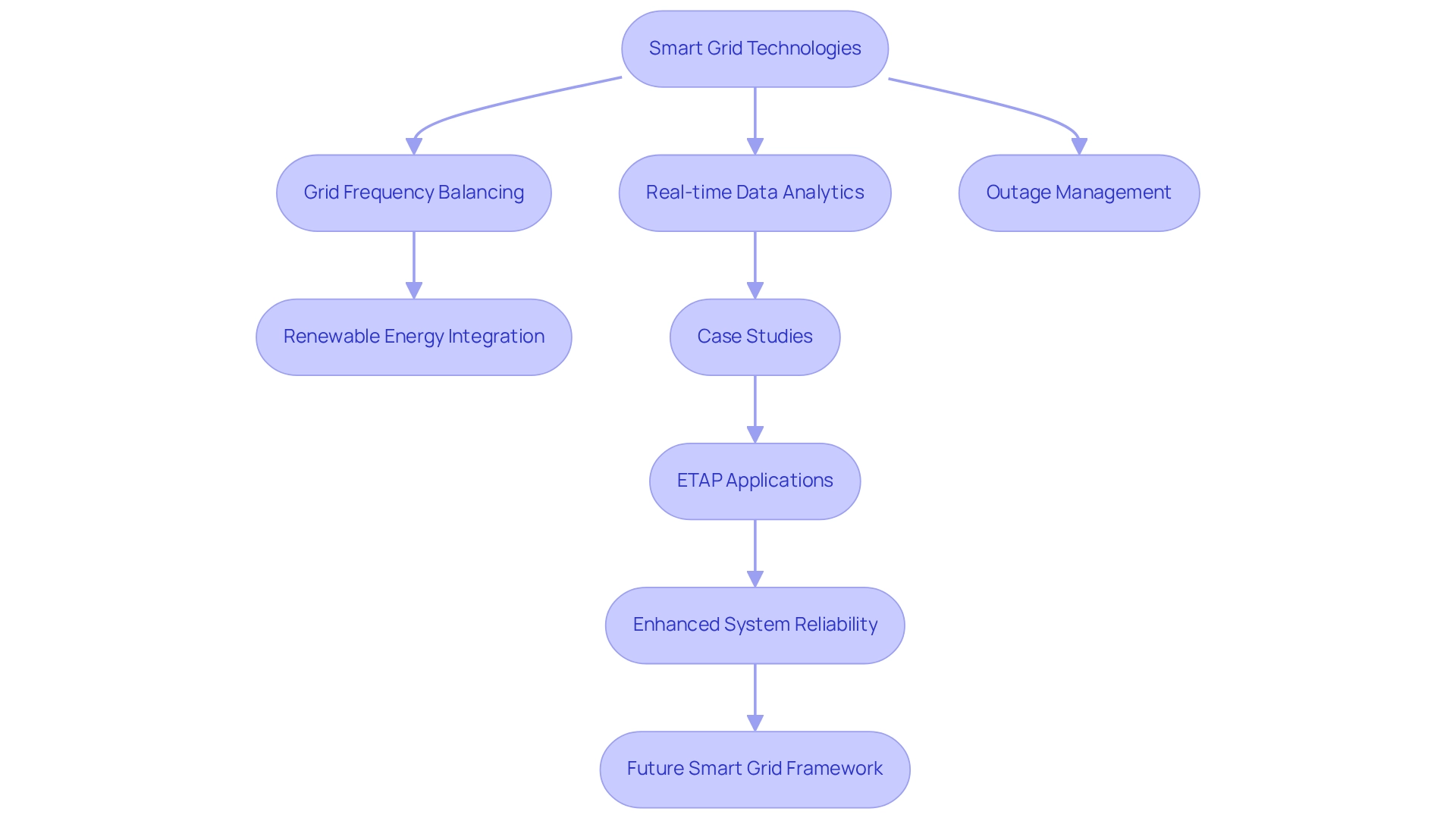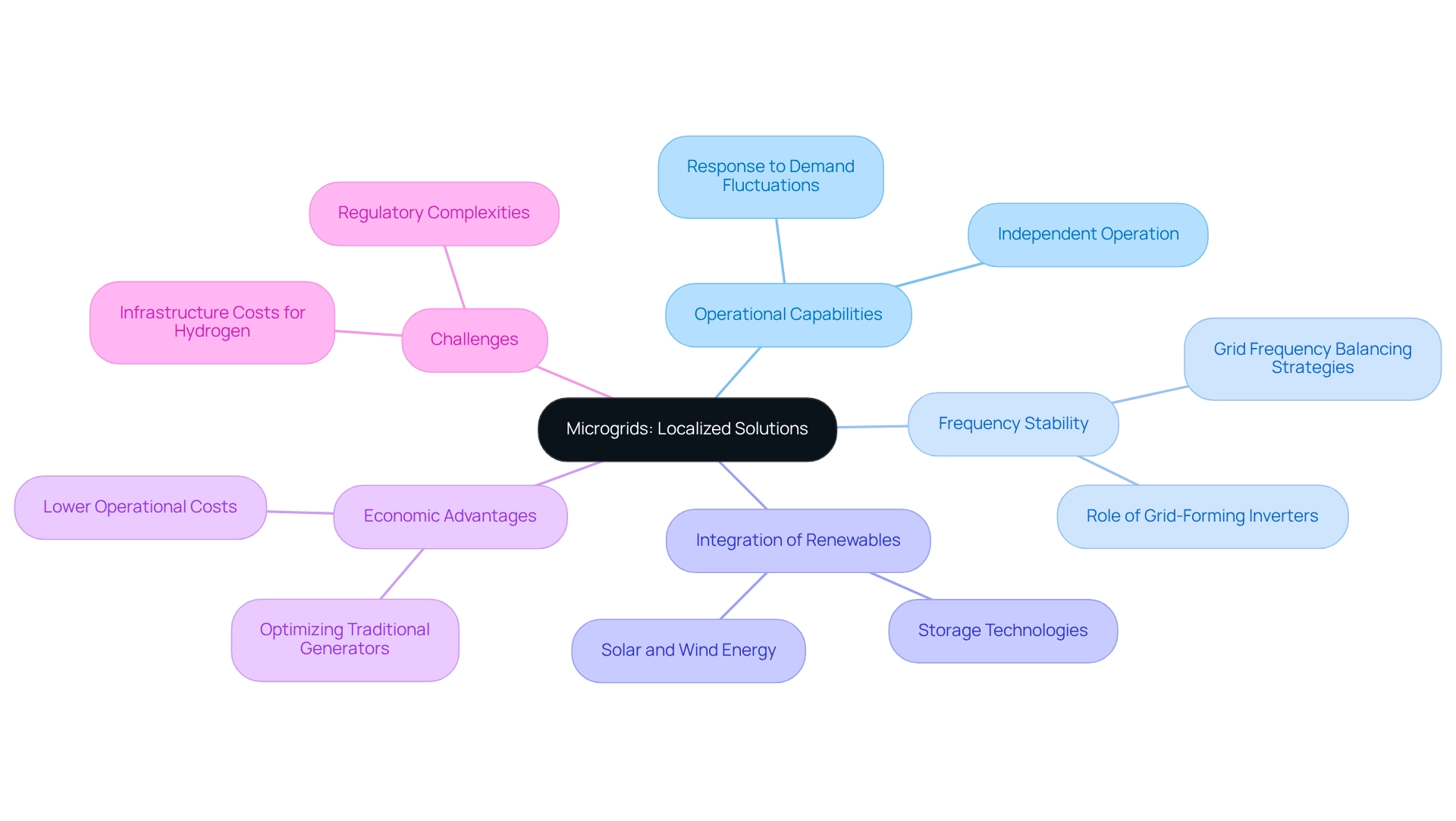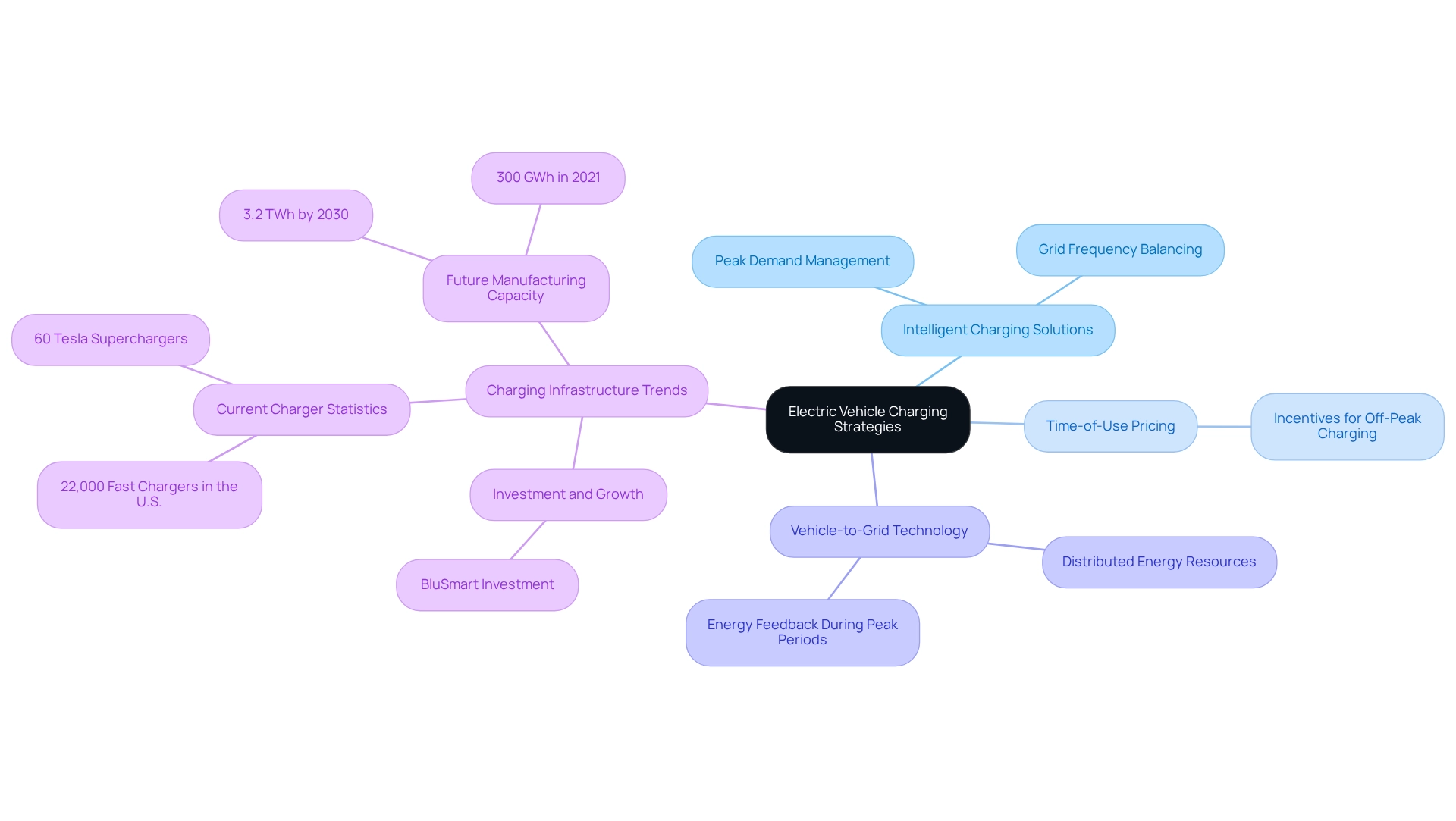Overview
This article delves into nine essential grid frequency balancing strategies that are critical for effective energy management. It highlights the integration of energy storage systems, demand response programs, smart grid technologies, and more. These strategies play a vital role in maintaining grid stability and reliability as the energy landscape undergoes significant transformation. With the increasing share of renewable energy sources, innovative approaches are necessary to manage variability and ensure a balanced supply-demand equilibrium.
Introduction
The energy landscape is experiencing a transformative shift, necessitated by the demand for stability and sustainability within an increasingly complex grid system.
With renewable energy sources such as wind and solar emerging as dominant forces, the challenges associated with managing their inherent variability are more pronounced than ever.
Innovative strategies, ranging from advanced energy storage solutions to smart grid technologies, are being developed to ensure a harmonious balance between supply and demand.
This article explores the multifaceted approaches being adopted—from demand response programs to localized microgrids—demonstrating how these initiatives are reshaping energy management and fostering a more resilient future.
As the industry navigates the complexities of frequency regulation and grid optimization, the collaborative efforts of utilities and cutting-edge technologies will be crucial in maintaining a reliable energy supply.
Harbinger Land | Comprehensive Solutions for Land Services in Energy and Infrastructure
In the challenging realm of land services for utility and infrastructure projects, Harbinger Land stands out as a leader. The complexities of land acquisition, particularly in the context of network modernization and sustainable power initiatives, present significant hurdles. Legal and regulatory challenges can complicate the process, making expert guidance essential.
Harbinger Land offers a comprehensive suite of services tailored to meet the needs of clients, including natural gas firms and solar developers. Their offerings encompass:
- Site and right-of-way acquisition
- Advanced title research
- GIS mapping
- Efficient data processing
By leveraging cutting-edge technology, such as AI-powered title research software and highly integrated GIS modeling services, they significantly enhance operational efficiency and client satisfaction.
The veteran team at Harbinger Land is adept at rapidly mobilizing large teams to address diverse project requirements. This flexibility is crucial in 2025, as power projects face increasing land acquisition obstacles. Their digitization of property data and efficient document imaging solutions streamline title research and leasing processes, enabling clients to confidently acquire land rights and assets in their areas of interest.
Are you prepared to navigate the complexities of land acquisition? With Harbinger Land's expertise, you can overcome challenges and ensure timely and accurate service delivery. Trust in their advanced solutions to facilitate your projects and drive success.
Energy Storage Systems: Enhancing Grid Frequency Stability
Storage systems (ESS) are essential for enhancing frequency stability through grid frequency balancing strategies that effectively manage the power supply and demand. By storing surplus power during low-demand periods and releasing it during peak times, technologies like lithium-ion batteries and pumped hydro storage offer rapid response capabilities that are crucial for grid operators. Currently, lithium-ion batteries dominate the storage market, holding a significant share due to their efficiency and scalability. The global market for these batteries is growing rapidly, propelled by the increasing integration of renewable power sources, which are often variable. Notably, Europe requires a battery storage capacity of 200 GW to facilitate its transition initiatives.
The impact of power storage systems on network stability is profound. Research indicates that effective implementation of ESS is crucial for grid frequency balancing strategies, which can substantially reduce frequency fluctuations and enhance overall system reliability. A recent case study titled "Challenges in Regulatory Frameworks for Storage" underscored the regulatory hurdles that impede the development of pumped-storage hydropower and grid-scale batteries. By revising these frameworks, power storage technologies can achieve improved economic viability, ultimately supporting network management efforts.
The practical applications of lithium-ion batteries in power management underscore their effectiveness. Projects utilizing these batteries have successfully demonstrated grid frequency balancing strategies during peak demand periods, showcasing their critical role in modern power systems. Experts assert that as the power landscape evolves, grid frequency balancing strategies will be vital alongside the integration of advanced storage solutions for maintaining system stability and managing the growing share of renewables. According to Precedence Research, the market is characterized by a diverse range of battery technologies and storage solutions, enhancing the competitive landscape among potential manufacturers and leading companies.
In 2025, ongoing advancements in power storage systems will continue to highlight their benefits for grid frequency balancing strategies in the network. As the market diversifies with various battery technologies, the competitive environment is set to expand, further enhancing the capabilities of power management systems. The strategic deployment of ESS not only assists grid operators but also fosters a more resilient and sustainable energy future. Currently, lithium-ion batteries maintain a substantial market share in power storage, emphasizing their importance in the ongoing evolution of resource management.

Demand Response Programs: Shifting Load for Frequency Balance
Response programs are essential in encouraging consumers to modify their energy usage during peak periods, effectively shifting load to off-peak times. By strategically lowering consumption when the system faces stress, these initiatives are essential in implementing grid frequency balancing strategies to preserve frequency stability. Utilities can implement a variety of strategies, such as time-based rates and direct load control, to motivate consumer participation. Notably, successful demand response strategies have shown significant improvements in grid resilience and the implementation of grid frequency balancing strategies.
Looking ahead to 2025, incentives for usage adjustments are expected to further enhance consumer engagement. Statistics indicate that 381 partners can save and convey privacy choices, reflecting a considerable percentage of consumers eager to participate in these programs. Specialist insights, including those from Matt Carrara, underscore the effectiveness of grid frequency balancing strategies in managing peak loads and ensuring a balanced power system, which ultimately benefits both consumers and utilities.
Moreover, these response programs align with Harbinger Land's objective to elevate client satisfaction through innovative solutions, reinforcing their commitment to addressing challenges in resource management.

Smart Grid Technologies: Optimizing Energy Distribution for Stability
Smart network technologies leverage advanced digital communication and automation to enhance power distribution and fortify network stability. Real-time data analytics empower utilities to effectively implement grid frequency balancing strategies that align power supply with demand, swiftly identify outages, and manage power flows with precision. This capability is particularly vital as the integration of renewable energy sources introduces variability into the system, necessitating grid frequency balancing strategies to improve adaptability. Notably, wireline communication technology remains the largest segment of the smart network market, underscoring its significance in power systems. Case studies, including the global applications of ETAP in intelligent network projects, showcase the successful implementation of these technologies, demonstrating their adaptability and efficiency in elevating electrical system performance. The ETAP case study highlights significant enhancements in system reliability and efficiency, providing a framework for future smart network implementations.
As the adoption rates of intelligent network technologies rise across the U.S., forecasts indicate considerable growth in the coming years. The integration of smart technologies is poised to substantially improve the reliability of distribution systems, paving the way for a more robust power future. According to Girish, the Smart Market report outlines the trends and growth factors influencing the sector, further affirming the essential role of smart technologies in the contemporary management of power.

Renewable Energy Integration: Managing Variability for Frequency Control
The integration of renewable power sources, such as wind and solar, poses significant challenges for frequency regulation due to their inherent intermittency. Addressing these challenges necessitates effective grid frequency balancing strategies. Energy storage systems are pivotal in this context, with investments in battery storage projected to surpass USD 35 billion in 2023, fueled by a robust pipeline of projects. These systems mitigate fluctuations in power supply, enabling network operators to maintain stability. Furthermore, demand response initiatives empower consumers to adjust their power consumption according to supply conditions, thereby enhancing network reliability.
Advanced forecasting techniques play a crucial role in predicting generation patterns, allowing operators to anticipate variability and make necessary adjustments. As renewable power sources are expected to emerge as the largest contributors to global electricity generation by 2027—accounting for 35% of total production—the urgency for grid frequency balancing strategies intensifies. Additionally, clear guidance on the standardization and certification of used EV batteries is vital to overcoming challenges in power storage, ensuring these systems can be seamlessly integrated into the grid.
Case studies underscore the importance of technological innovations in battery storage, particularly advancements in lithium-ion and flow batteries, which are essential for enhancing storage capabilities and driving down costs. As Max Schoenfisch noted, "This new World Energy Outlook Special Report offers the most thorough examination to date of the intricate connections between these minerals and the potential for a safe, swift transition of the sector."
In summary, managing the variability of renewable power sources necessitates grid frequency balancing strategies that encompass storage, demand response, and sophisticated forecasting. These strategies not only mitigate the impacts of variability but also ensure a stable and reliable power supply as the transition to renewables accelerates.
Microgrids: Localized Solutions for Enhanced Frequency Stability
Microgrids represent a pivotal advancement in localized power systems, capable of operating independently or in conjunction with the main grid. This capability significantly enhances grid frequency balancing strategies for improved frequency stability. By implementing localized generation and storage solutions, microgrids can swiftly respond to demand fluctuations, utilizing grid frequency balancing strategies to ensure a reliable power supply. Their integration of renewable energy sources, such as solar and wind, alongside storage technologies, facilitates effective management of variability in production and consumption.
In the United States, the current landscape boasts over 2,000 operational microgrids, highlighting a growing trend towards decentralized power solutions. However, the complexities of permitting and regulatory processes across states can prolong project timelines and escalate costs for microgrid installations, a crucial consideration for land acquisition professionals. These systems not only bolster network resilience but also aid in the integration of renewable resources, thereby reducing dependence on traditional fossil fuels. For instance, in aerospace applications, microgrids have proven essential for enhancing power efficiency and reliability, particularly in electrified aviation systems.
Furthermore, microgrids offer economic advantages by optimizing the utilization of traditional generators, allowing them to operate at full capacity. This capability enhances overall system performance and lowers operational costs. While fuel cells are noted for their low emissions, it is important to consider the challenges associated with hydrogen extraction and the necessity for costly infrastructure. As the energy sector evolves, the implementation of microgrids serves as grid frequency balancing strategies to achieve grid independence and stability, ultimately fostering a more sustainable energy future. Additionally, grid-forming inverters play a crucial role in managing voltage and stability, further enhancing the technical capabilities of microgrids.

Frequency Regulation Services: Ensuring Supply-Demand Balance
Grid frequency balancing strategies are vital for maintaining the delicate equilibrium between electricity supply and consumption in real-time. These services utilize grid frequency balancing strategies by dynamically adjusting generation output or load in response to fluctuations in oscillation, ensuring that the network operates within its required oscillation range.
Utilities deploy a variety of resources, including:
- Conventional power plants
- Power storage systems
- Demand response programs
to deliver these essential services, while employing grid frequency balancing strategies. By 2025, real-time management strategies for oscillation have advanced significantly, with utilities integrating distributed resources such as customer demand response and electric vehicles. This integration not only enhances system reliability but also supports grid frequency balancing strategies by reducing ramp rates, accommodating the growing share of renewable power sources.
The Pacific Northwest National Lab emphasizes the potential of smart technology and distributed assets in providing ancillary services, which are crucial for the efficient regulation of electrical supply and the implementation of grid frequency balancing strategies. Statistics indicate that effective regulation services can greatly improve network operations. Studies from the National Renewable Energy Laboratory suggest that achieving an 80% carbon reduction by 2050 is attainable, contingent upon the successful implementation of these services.
Specifically, effective management of cycles is essential for addressing the variability of renewable power sources, thereby facilitating the transition to a low-carbon grid. Real-world examples illustrate how utilities maintain supply-demand equilibrium through innovative grid frequency balancing strategies, showcasing the efficiency of existing resources employed for frequency regulation in the U.S.
As the power landscape evolves, the importance of grid frequency balancing strategies in balancing supply and demand in real-time cannot be overstated. These services are crucial not only for operational stability but also for facilitating grid frequency balancing strategies that propel the transition to a more sustainable energy future. Furthermore, it is imperative to recognize that these services operate under the oversight of the Public Utility Commission of Texas and the Texas Legislature, ensuring adherence to regulatory standards.

Advanced Forecasting Techniques: Predicting Demand for Frequency Management
Advanced forecasting methods, particularly those that leverage machine learning and statistical modeling, are vital in accurately predicting electricity consumption. By meticulously analyzing historical data alongside real-time inputs, utilities can anticipate fluctuations in demand and adapt their generation strategies accordingly. This proactive approach is crucial for grid frequency balancing strategies and ensuring a reliable power supply, especially during peak usage periods.
Take, for instance, the Osprey Optimization Algorithm (OOA), inspired by the hunting behavior of ospreys. This algorithm has shown significant potential in enhancing electricity consumption prediction models. The OOA improves exploration of the search space and converges on optimal solutions, proving its effectiveness in addressing complex prediction challenges in resource management.
Moreover, the application of machine learning in power forecasting is gaining momentum, with research indicating that these techniques can markedly enhance the accuracy of consumption predictions. The efficacy of hybrid models across varying climatic conditions further highlights the adaptability of these forecasting methods, which is essential for utilities operating in diverse environments. For example, the annual wind speed in Sichuan fluctuates between 8 km/h and 4 km/h, averaging approximately 5.43 km/h, illustrating how weather patterns can impact electricity usage.
As the resource landscape evolves, integrating advanced forecasting techniques will be imperative for utilities aiming to optimize their operations and meet the rising demands of consumers. Brett Wharton from NexusMKTG underscores the significance of leveraging AI to bolster strengths and improve productivity in complex tasks, stating, "Use AI to amplify your strengths. Lean into your human skills — your ability to relate to people, express yourself, create systems, make decisions, and delight customers. Eventually, AI will do more of this work."
Looking ahead to 2025, the continued advancement of machine learning in requirement forecasting is expected to yield even more precise insights, which will further support grid frequency balancing strategies. Understanding the intricate interplay of factors influencing annual electricity needs, such as weather fluctuations and population growth, will be essential for effective energy management.
Electric Vehicle Charging Strategies: Managing Peak Demand for Frequency Balance
Electric vehicle charging approaches are critical for managing peak usage on the network. The implementation of intelligent charging solutions, which adjust charging times based on real-time network conditions, enables utilities to use grid frequency balancing strategies to mitigate the impact of EV charging on frequency stability. For instance, time-of-use pricing incentivizes EV owners to charge during off-peak hours, effectively minimizing usage surges. Additionally, vehicle-to-grid (V2G) technology transforms EVs into distributed energy resources, allowing them to feed energy back into the network during peak periods, thus providing essential support.
Current trends indicate a significant shift towards these intelligent charging solutions, with the U.S. boasting 22,000 fast chargers, 60% of which are Tesla Superchargers. As the global automotive landscape evolves, forecasts suggest that by 2030, lithium-ion battery manufacturing capacity will escalate to 3.2 TWh, a substantial increase from 300 GWh in 2021. This expansion in production capability is vital to accommodate the anticipated rise in electric vehicles on the roads, necessitating innovative charging strategies and grid frequency balancing strategies to ensure system stability and reliability.
Successful implementations of intelligent charging solutions have already demonstrated their effectiveness in managing peak usage. Utilities that have adopted these technologies report enhanced network performance and heightened customer satisfaction. Moreover, Charge Point Operators must leverage technology to improve customer experience and service reliability, which is essential as the future of EV charging infrastructure continues to progress.
In January 2024, BluSmart announced a $25 million investment from responsAbility Investments AG, underscoring the ongoing innovation and funding required to meet the increasing demands of integrating electric vehicles into the power landscape.

Utility Collaboration: Developing Effective Frequency Balancing Strategies
Utility collaboration is essential in developing effective grid frequency balancing strategies crucial for grid stability. By pooling resources, sharing information, and exchanging best practices, utilities can significantly enhance their collective capacity to manage fluctuations in power demand and supply. Collaborative initiatives often include joint demand response programs, enabling utilities to synchronize their responses to peak load conditions. Successful collaborations have emerged where utilities align renewable resource integration, optimizing the use of shared storage solutions to mitigate variability.
Statistics indicate that utilities engaged in collaborative resource management experience improved operational efficiency, with many reporting greater grid reliability. Studies reveal that utilities that collaborate effectively can achieve up to a 20% increase in operational efficiency compared to their non-collaborative counterparts. Recent examples of collaborative demand response initiatives illustrate how utilities can efficiently maintain stability through coordinated efforts, resulting in a more resilient energy system. As Brian Tracy aptly stated, "Success is nothing but small, positive actions done repeatedly," underscoring the significance of consistent collaborative efforts among utilities.
Moreover, the concept of aligning vibrations is exemplified by the case study titled 'The Pooh Business Strategy,' which illustrates that consistent actions lead to successful outcomes. This case study reinforces the need for utilities to coordinate their strategies and actions to achieve effective balance. Additionally, factors such as weather, population density, and tree density significantly influence utilities' capacity to maintain service, highlighting the challenges they face in load balancing. As the energy landscape evolves, the emphasis on utility collaboration will be vital for establishing grid frequency balancing strategies.

Conclusion
The energy landscape is undergoing a significant transformation, as the integration of renewable energy sources and advanced technologies reshapes electricity management. Key strategies such as energy storage systems, demand response programs, and smart grid technologies are crucial in addressing the challenges posed by variability in energy supply and demand. By harnessing these innovative solutions, utilities can enhance grid frequency stability, ensuring a reliable and resilient energy supply.
As the adoption of renewable energy continues to rise, effective management strategies will become increasingly vital. The deployment of localized microgrids, advanced forecasting techniques, and collaborative efforts among utilities are essential in optimizing energy distribution and maintaining the delicate balance between supply and demand. These initiatives not only bolster operational efficiency but also pave the way for a more sustainable energy future.
In conclusion, the collaborative efforts of utilities, combined with cutting-edge technologies, are pivotal in navigating the complexities of the modern energy landscape. Embracing these multifaceted approaches will be key to achieving a stable and resilient grid system, ultimately supporting the transition towards a cleaner and more sustainable energy paradigm. The future of energy management lies in innovation, collaboration, and adaptability, ensuring that the growing demands of consumers are met with reliability and efficiency.
Frequently Asked Questions
What services does Harbinger Land offer for utility and infrastructure projects?
Harbinger Land offers a comprehensive suite of services, including site and right-of-way acquisition, advanced title research, GIS mapping, and efficient data processing.
How does Harbinger Land enhance operational efficiency?
Harbinger Land leverages cutting-edge technology, such as AI-powered title research software and highly integrated GIS modeling services, to significantly enhance operational efficiency and client satisfaction.
What challenges do power projects face in 2025 regarding land acquisition?
Power projects face increasing land acquisition obstacles, which require expert guidance and rapid mobilization of large teams to address diverse project requirements.
How does Harbinger Land streamline the land acquisition process?
Harbinger Land digitizes property data and utilizes efficient document imaging solutions to streamline title research and leasing processes, enabling clients to confidently acquire land rights and assets.
What is the role of energy storage systems (ESS) in grid frequency balancing?
Energy storage systems enhance frequency stability by managing power supply and demand, storing surplus power during low-demand periods, and releasing it during peak times.
Why are lithium-ion batteries significant in the energy storage market?
Lithium-ion batteries dominate the storage market due to their efficiency and scalability, and they play a crucial role in grid frequency balancing strategies.
What are the anticipated developments in power storage systems by 2025?
Ongoing advancements in power storage systems are expected to highlight their benefits for grid frequency balancing, with a diverse range of battery technologies enhancing the competitive landscape.
How do response programs contribute to grid frequency stability?
Response programs encourage consumers to modify their energy usage during peak periods, effectively shifting load to off-peak times, which is essential for preserving frequency stability.
What strategies can utilities implement to motivate consumer participation in response programs?
Utilities can implement strategies such as time-based rates and direct load control to encourage consumer participation in response programs.
How does Harbinger Land align its objectives with response programs?
Harbinger Land aims to elevate client satisfaction through innovative solutions, which includes addressing challenges in resource management and supporting demand response initiatives.
List of Sources
- Harbinger Land | Comprehensive Solutions for Land Services in Energy and Infrastructure
- 20 Quotes To Get You Inspired For a Renewable Future - Solstice (https://solstice.us/solstice-blog/20-quotes-for-a-renewable-future)
- Solar Market Insight Report – SEIA (https://seia.org/research-resources/us-solar-market-insight)
- 60 Quotes About the Future of Renewable Energy (https://deliberatedirections.com/renewable-energy-quotes)
- How Much Land Is Needed for 100% Renewable Energy? (Latest Research Stats) (https://patentpc.com/blog/how-much-land-is-needed-for-100-renewable-energy-latest-research-stats)
- Energy Storage Systems: Enhancing Grid Frequency Stability
- EU power grid needs trillion-dollar upgrade to avert Spain-style blackouts (https://reuters.com/sustainability/climate-energy/eu-power-grid-needs-trillion-dollar-upgrade-avert-spain-style-blackouts-2025-05-05)
- Energy storage - IEA (https://iea.org/energy-system/electricity/grid-scale-storage)
- Energy Storage Systems Market Size is Expanding US$ 569.39 Billion by 2034 (https://globenewswire.com/news-release/2025/04/07/3057015/0/en/Energy-Storage-Systems-Market-Size-is-Expanding-US-569-39-Billion-by-2034.html)
- Demand Response Programs: Shifting Load for Frequency Balance
- Small data centers, big impact: How demand response can fuel the energy transition (https://utilitydive.com/news/small-data-centers-big-impact-how-demand-response-can-fuel-the-energy-transition/745571)
- Demand response could be crucial to the energy transition. Why aren't we using it more? (https://renewableenergyworld.com/power-grid/demand-response-could-be-crucial-to-the-energy-transition-why-arent-we-using-it-more)
- 20 Quotes To Get You Inspired For a Renewable Future - Solstice (https://solstice.us/solstice-blog/20-quotes-for-a-renewable-future)
- Smart Grid Technologies: Optimizing Energy Distribution for Stability
- Smart Grid Market Size, Share, and Industry Report [2024-2030] (https://marketsandmarkets.com/Market-Reports/smart-grid-market-208777577.html)
- Investigation of smart grid technologies deployment for energy reliability enhancement in electricity distribution networks (https://sciencedirect.com/science/article/pii/S2773186325000179)
- Renewable Energy Integration: Managing Variability for Frequency Control
- Energy storage - IEA (https://iea.org/energy-system/electricity/grid-scale-storage)
- 10 Surprising Renewable Energy Statistics for 2023 (https://gridx.com/renewable-energy-statistics)
- Microgrids: Localized Solutions for Enhanced Frequency Stability
- U.S Microgrid Market Size Report, 2021-2026 (https://industryarc.com/Report/19780/us-microgrid-market-report)
- sciencedirect.com (https://sciencedirect.com/science/article/pii/S2211467X23000779)
- Frequency Regulation Services: Ensuring Supply-Demand Balance
- ERCOT Adds New Ancillary Service to Support Grid Reliability (https://ercot.com/news/release/2023-06-12-ercot-adds-new)
- Ancillary Services Primer | NESCOE (https://nescoe.com/resource-center/ancillary-services-primer-sep2017)
- Advanced Forecasting Techniques: Predicting Demand for Frequency Management
- Forecasting for electricity demand utilizing enhanced inception-V4 using improved Osprey optimization - Scientific Reports (https://nature.com/articles/s41598-024-81487-8)
- 75 Quotes About AI: Business, Ethics & the Future (https://deliberatedirections.com/quotes-about-artificial-intelligence)
- Electric Vehicle Charging Strategies: Managing Peak Demand for Frequency Balance
- 10 EV Charging Statistics You Should Know | KORE (https://korewireless.com/blog/ev-charging-statistics)
- Electric Vehicle Charging Infrastructure Statistics and Facts (2025) (https://scoop.market.us/electric-vehicle-charging-infrastructure-statistics)
- Utility Collaboration: Developing Effective Frequency Balancing Strategies
- EIA data show average frequency and duration of electric power outages - U.S. Energy Information Administration (EIA) (https://eia.gov/todayinenergy/detail.php?id=27892)
- Albert Einstein Quotes About Energy | A-Z Quotes (https://azquotes.com/author/4399-Albert_Einstein/tag/energy)
- EINSTEIN, FREQUENCY, & THE LAW OF SUCCESS – Gavin Sharples (https://gavinsharples.co.za/einstein-frequency-the-law-of-success)




